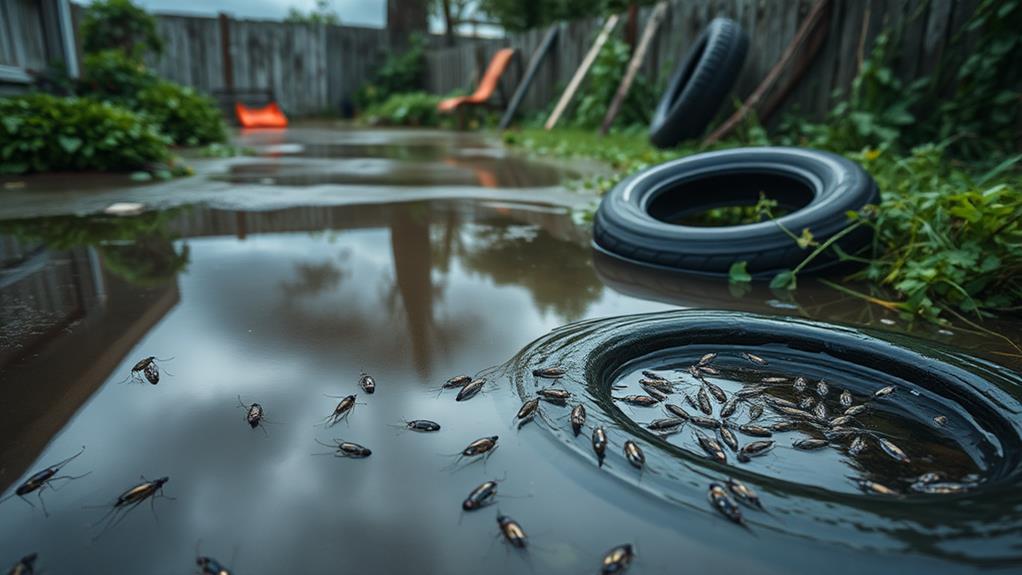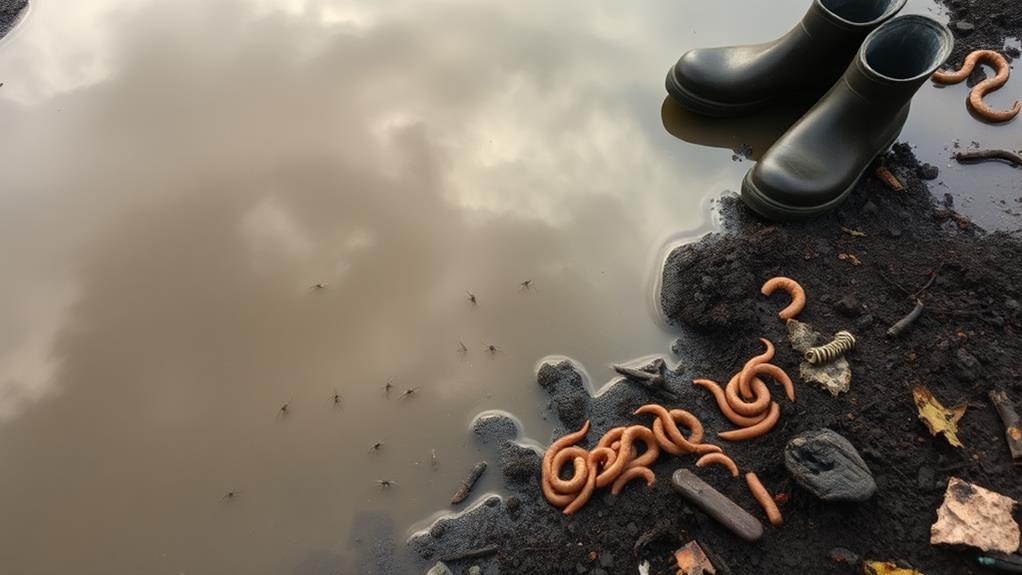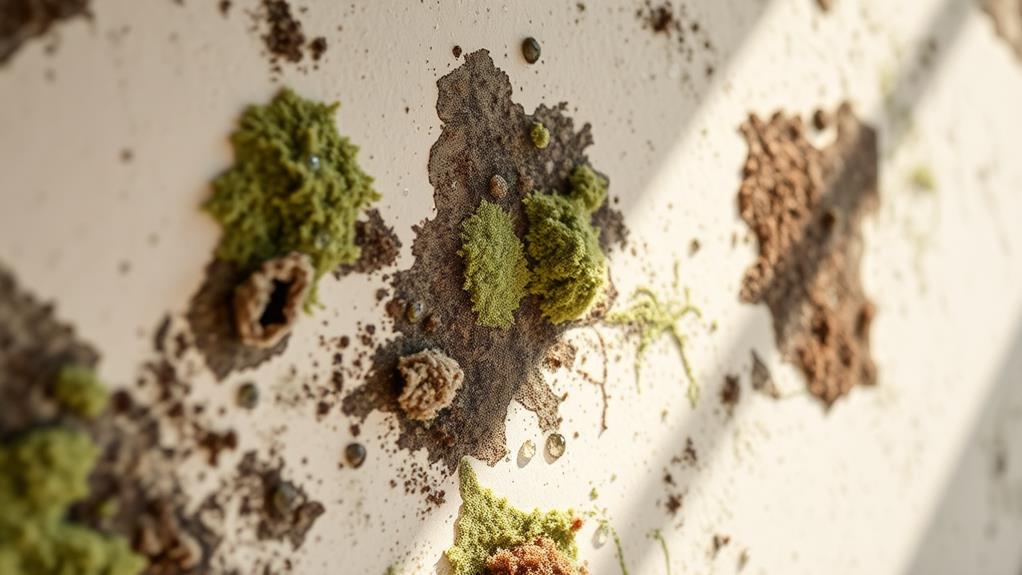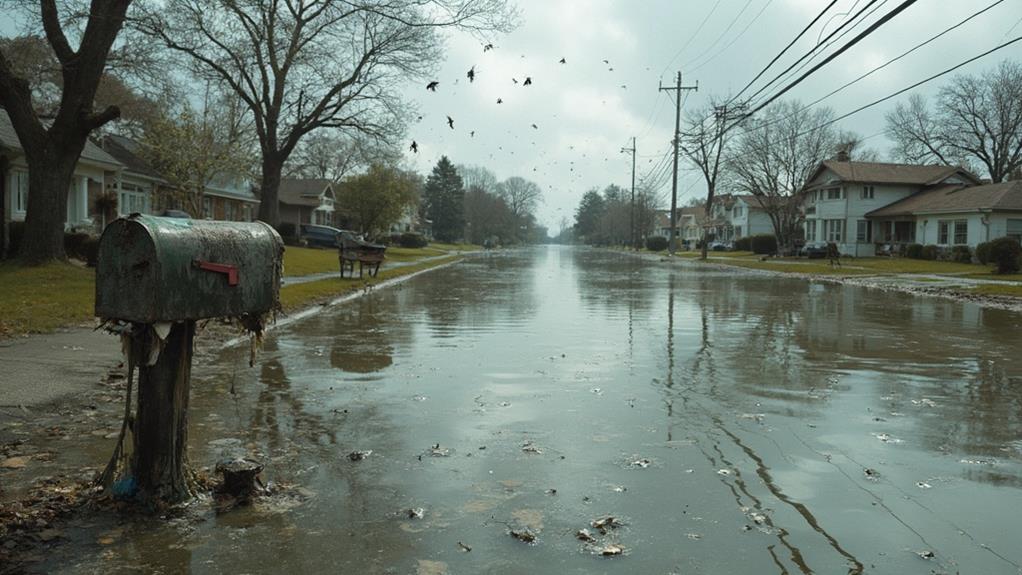Standing water after a storm presents five major health risks. Mosquito-borne diseases like West Nile virus can spread rapidly. Bacterial infections from E. coli and Salmonella may occur through direct contact. Parasites such as Giardia can cause gastrointestinal illnesses. Chemical contamination from industrial pollutants poses risks of skin irritation and organ damage. Mold and fungal growth can trigger respiratory problems and allergic reactions. These hazards underscore the importance of avoiding contact with standing water and promptly addressing flood-related issues. Understanding the specific dangers and preventive measures can significantly reduce the risk of post-storm health complications.
Mosquito-Borne Diseases

Standing water's most notorious health risk comes from mosquito-borne diseases. After storms, stagnant pools become ideal breeding grounds for mosquitoes, which can transmit various pathogens to humans. Common diseases spread by these insects include West Nile virus, Zika virus, dengue fever, and chikungunya.
West Nile virus, the most prevalent mosquito-borne disease in the United States, can cause severe neurological complications in some cases. Zika virus poses significant risks to pregnant women, potentially leading to birth defects.
Dengue fever, though less common in temperate regions, can cause severe flu-like symptoms and, in rare cases, life-threatening hemorrhagic fever. Chikungunya, while rarely fatal, often results in debilitating joint pain that can persist for months or years.
To mitigate these risks, it's crucial to eliminate standing water around homes and communities as quickly as possible after storms. This includes emptying containers, clearing gutters, and filling in low-lying areas. Personal protection measures, such as using insect repellents and wearing long-sleeved clothing, are also essential in reducing exposure to mosquito bites and the diseases they carry.
Bacterial Infections
Bacterial infections crop up as another significant health hazard associated with standing water after storms. Floodwaters often contain sewage, animal waste, and other contaminants that harbor harmful bacteria. Common bacteria found in these waters include E. coli, Salmonella, and Leptospira, which can cause severe gastrointestinal illnesses and infections.
Direct contact with contaminated water, whether through wading, cleaning, or accidental ingestion, can lead to bacterial infections. These infections may manifest as skin rashes, open wound infections, or internal illnesses. Leptospirosis, a bacterial disease spread through animal urine in floodwaters, can cause flu-like symptoms and, in severe cases, organ failure.
To minimize the risk of bacterial infections, avoid contact with standing water whenever possible. If exposure is unavoidable, wear protective gear such as waterproof boots, gloves, and goggles. Thoroughly clean and disinfect any items that come into contact with floodwater, and wash hands frequently with soap and clean water. Seek immediate medical attention if you experience symptoms of infection after exposure to standing water, as prompt treatment is crucial in preventing complications from bacterial infections.
Parasitic Infections

While bacterial infections pose a significant risk, parasitic infections are another serious health concern associated with standing water after storms. Parasites like Giardia, Cryptosporidium, and various helminths can thrive in contaminated floodwaters. These organisms can enter the body through ingestion of contaminated water or through skin contact with infected water, particularly if there are open wounds or cuts.
Giardia and Cryptosporidium are protozoan parasites that cause gastrointestinal illnesses, leading to symptoms such as diarrhea, abdominal cramps, and nausea. These parasites are resistant to many water treatment methods, making them particularly problematic in post-storm scenarios.
Helminths, including hookworms and roundworms, can penetrate the skin and cause various health issues, including anemia and malnutrition.
To prevent parasitic infections, avoid direct contact with standing water whenever possible. If exposure is unavoidable, wear protective clothing and footwear. Thoroughly clean and disinfect any items that come into contact with floodwater. Boil all drinking water or use approved water purification methods. Seek medical attention promptly if you experience symptoms of parasitic infection, as early treatment is crucial for preventing severe complications and limiting the spread of these organisms.
Chemical Contamination
Floodwaters' potential for chemical contamination poses a significant health risk in the aftermath of storms. Standing water can accumulate various hazardous substances, including industrial chemicals, pesticides, and petroleum products. These contaminants may originate from damaged storage facilities, agricultural runoff, or sewage systems overwhelmed by flooding.
Exposure to chemically contaminated floodwater can lead to severe health consequences. Skin contact may cause irritation, rashes, or chemical burns, while ingestion can result in gastrointestinal distress, organ damage, or long-term health effects. Inhalation of volatile compounds released from contaminated water can cause respiratory issues and other systemic problems.
Chemical contaminants in standing water also pose environmental risks. As floodwaters recede, these substances can seep into the soil, potentially contaminating groundwater and affecting local ecosystems. This contamination can persist long after the immediate flood event, creating ongoing health and environmental challenges for affected communities.
To mitigate risks associated with chemical contamination in standing water, authorities should conduct thorough water quality assessments, implement proper clean-up procedures, and provide clear guidance to residents on avoiding exposure. Personal protective equipment is essential for those involved in flood clean-up efforts to minimize contact with potentially contaminated water.
Mold and Fungal Growth

Beyond the immediate chemical hazards, standing water after storms creates an ideal environment for mold and fungal growth. These microorganisms thrive in moist conditions, rapidly colonizing damp surfaces and materials. Within 24 to 48 hours of water exposure, mold can begin to proliferate, posing significant health risks to individuals in affected areas.
Exposure to mold spores can trigger a range of health issues, particularly in sensitive individuals. Common symptoms include respiratory problems, allergic reactions, and skin irritation. For those with pre-existing conditions such as asthma or weakened immune systems, the risks are even more severe. Certain mold species produce mycotoxins, which can cause more serious health effects upon prolonged exposure.
Fungal growth in standing water can also lead to the development of harmful pathogens. Some fungi, like Aspergillus and Stachybotrys chartarum (black mold), are particularly concerning due to their potential to cause severe respiratory infections and other health complications. To mitigate these risks, it is crucial to remove standing water promptly and thoroughly dry affected areas. Professional remediation may be necessary for extensive mold infestations to ensure safe and complete removal.
Frequently Asked Questions
How Long Does Standing Water Typically Remain After a Storm?
The duration of standing water after a storm varies depending on factors such as terrain, drainage systems, and weather conditions. Typically, it can persist for a few hours to several days, with some areas experiencing prolonged flooding for weeks.
Can I Safely Wade Through Standing Water to Assess Property Damage?
Did you know that 60% of flood-related deaths occur when people attempt to walk through floodwaters? It's not safe to wade through standing water. Hazards like debris, contaminants, and electrical dangers pose significant risks. Avoid entering floodwaters whenever possible.
What Protective Gear Should I Wear When Cleaning up Standing Water?
When cleaning up standing water, wear waterproof boots, rubber gloves, and protective eyewear. Consider using a face mask or respirator to prevent inhalation of contaminants. Wear long sleeves and pants to minimize skin contact with potentially contaminated water.
How Can I Safely Dispose of Standing Water on My Property?
Like draining a swamp, safely disposing of standing water requires careful planning. To remove it from your property:
- Pump large areas
- Use buckets for smaller puddles
- Create drainage paths
- Treat remaining water with larvicides
- Fill in low spots
Are There Any Health Risks for Pets Exposed to Standing Water?
Pets exposed to standing water face several health risks, including bacterial infections, parasitic diseases, and chemical contamination. They may contract leptospirosis, giardiasis, or suffer from skin irritations. Ingestion of contaminated water can lead to gastrointestinal issues and other illnesses.
Conclusion
Standing water, a silent harbinger of health hazards, casts a long shadow in the aftermath of storms. Like a siren's call, it lures unsuspecting victims into a web of risks, from the buzzing menace of mosquito-borne diseases to the invisible threat of bacterial and parasitic infections. Chemical contaminants lurk beneath the surface, while mold and fungi silently colonize damp spaces. Vigilance and proper precautions are essential to navigate these treacherous waters and safeguard community health in the wake of nature's fury.

